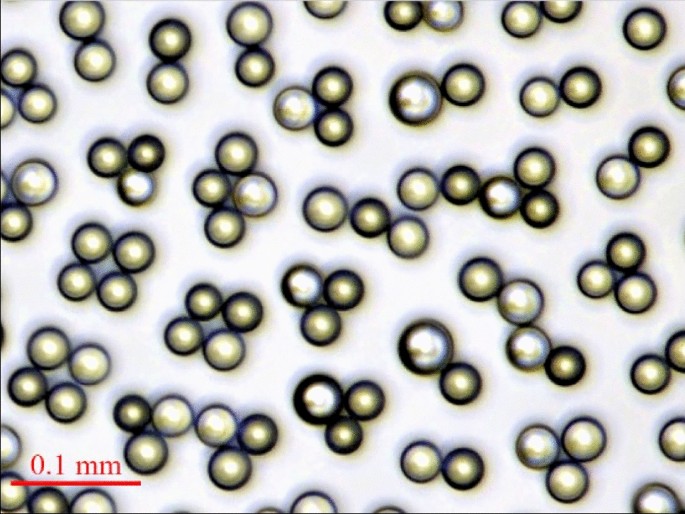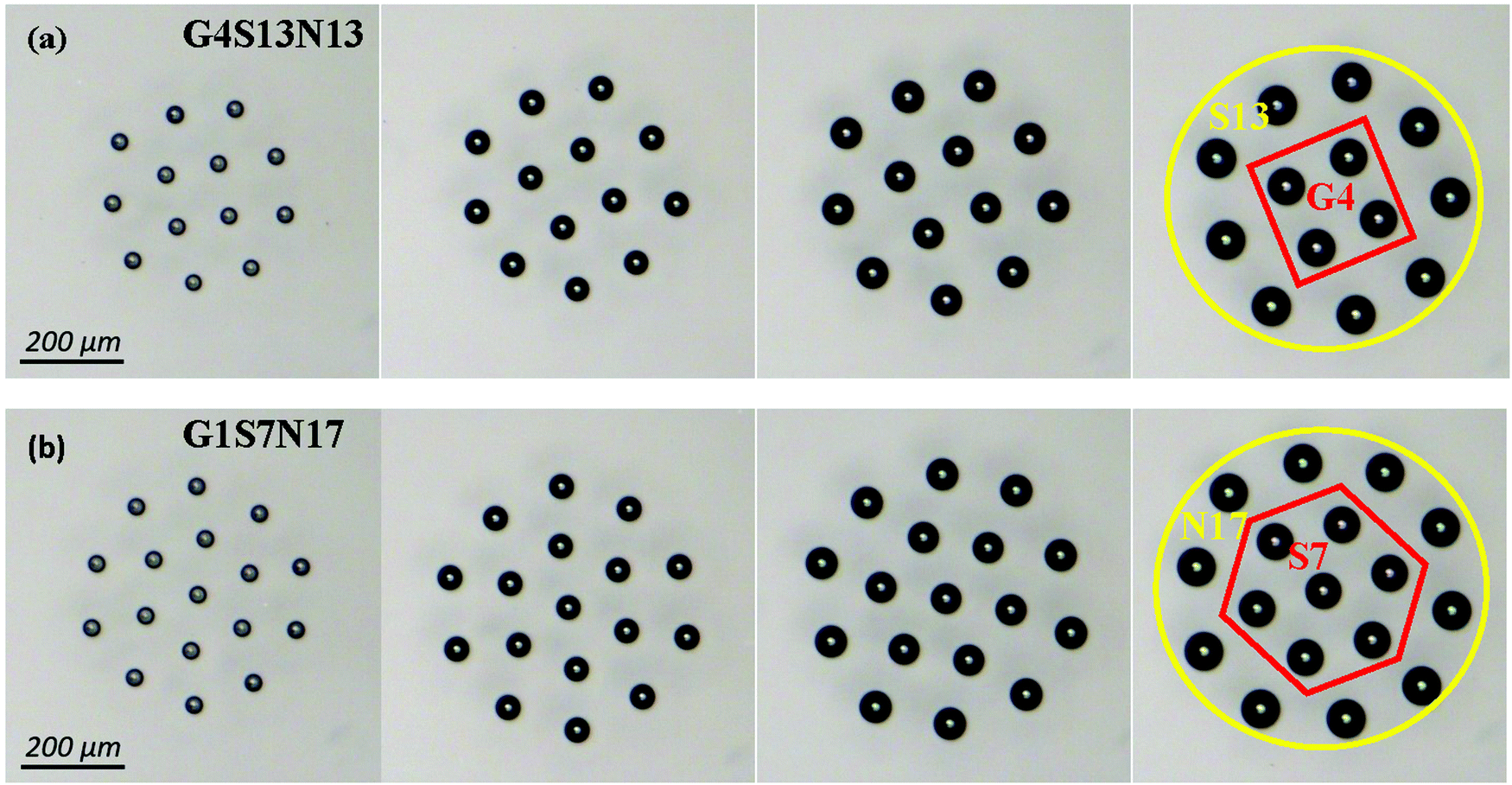The levitating microdroplet cluster is a new phenomenon, which was discovered for the first time in 2004 by Alexander Fedorets. The droplet cluster is typologically similar to self-assembled colloidal crystals, but it has some features absent from colloidal clystals. Thus, in most colloidal crystals hardcore repulsion forces are responsible for packing of colloid particles, while in the droplet cluster the repulsion between droplets is much more complex. The droplet cluster is sometimes compared to the Leidenfrost effect, but the phenomenon is very different (please see my earlier blog entry for the comparison). The hexagonal (honeycomb) self-assembly is also similar to the Rayleigh–Bénard convection cells.
Since the droplet cluster was discovered for the first time in 2004, new types of clusters were found. It is good to list here different types of droplet clusters known so far:
1. Most common hexagonal (honeycomb shaped) droplet cluster.
The droplet cluster is a self-assembled levitating monolayer of microdroplets often arranged into a hexagonally-ordered structure over a locally heated thin (about 1 mm) layer of water. The radius of the droplets is in the range of 0.01 mm – 0.1 mm, while the levitation height is of the same order of magnitude. The droplets are condenced in the accending air-vapor stream (or jet) and suspended at the levitation height where their weight is equilibrated by the gas drag force. Flow dynamics leads to the effective “repulsion forces” between the droplets preventing them from coalescing.

2. The Chain cluster.
In this cluster, some rotating droplets may be very close to each other but viscosity of the thin gas layer between the droplets prevents them from coalescing. There is a reversible structural transition from the ordered hexagonal-structure cluster to the chain-like structure.
The hexagonal-to-chain structural transition depends mainly on the number of droplets in the cluster or on its size. The cluster levitates at a small height above the water layer, and the ascending gas stream passes between the central water droplets. When there are few droplets in a cluster, the core of the cluster is not constrained by the outer layers of droplets and the growing droplets have the opportunity to move apart. In a large cluster, droplets in the central are constrained by the outer droplets and the distance between them decreases with the growing diameter of the droplets. The resistance of the cluster to the upward gas stream increases, which causes structure reorganization. Instead of uniformly distributed droplets of the hexagonal cluster, chains of droplets with relatively wide gaps between them emerge.
A. A. Fedorets et al. “Self-arranged levitating droplet clusters: a reversible transition from hexagonal to chain structure” Langmuir 2019, 35, 47, 15330–15334 https://doi.org/10.1021/acs.langmuir.9b03135
Droplet Cluster With Chain Structures
The “lacy cluster” is a variation of the chain cluster:

3. Hierarchical cluster.
A hierarchical cluster is built of small groups of droplets. Unlike earlier observed droplet clusters controlled by aerodynamic forces, which formed either an ordered hexagonal structure or a chain structure, the cluster under consideration has a hierarchical organization. Small groups of closely spaced or packed droplets with interactions controlled by the electrostatic force are combined into larger structures controlled by aerodynamic forces. Since charged droplets in the nucleus of the cluster do not have dynamically stable configurations, droplet aggregates keep continuously restructuring The droplets permanently keep rearranging, so the phenomenon is the “deterministic chaos”

A. Fedorets, L. A. Dombrovsky, E Bormashenko, and M. Nosonovsky “A hierarchical levitating cluster containing transforming small aggregates of water droplets” Microfluidics and Nanofluidics, 26, 52 (2022), https://doi.org/10.1007/s10404-022-02557-9
4. Ring cluster.
The thermocapillary (TC) flow at the surface of the water layer combined with the convective flow in the layer often prevents a cluster’s stability due to disturbances that it creates in the gas flow over the water surface. The TC flow can be suppressed by introducing small amounts of surfactants into the water layer. In the absence of the surfactant, a ring-shaped cluster is formed.

Alexander A. Fedorets, Dmitry V. Shcherbakov, Leonid A. Dombrovsky, Edward Bormashenko, and Michael Nosonovsky, “Impact of Surfactants on the Formation and Properties of Droplet Clusters” Langmuir 2020, 36, 37, 11154–11160, https://doi.org/10.1021/acs.langmuir.0c02241
5. Small clusters.
Large clusters form hexagonally ordered (honeycomb) structures similar to colloidal crystals, while small (from one to several dozens of droplets) clusters possess special symmetry properties. Small clusters may demonstrate 4-fold, 5-fold, and 7-fold symmetry which is absent from large clusters and crystals. The symmetry properties of small cluster configurations are universal, i.e., they do not depend on the size of the droplets and details of the interactions between the droplets. The small cluster configurations may be compared with other types of symmetric objects in geometry.

Small droplet clusters have unusual symmetries absent from colloidal crystals and from large clusters. In our new paper, we discuss the hypothesis that the symmetries of small clusters may be related to an amazing mathematical object, the ADE-classification based on the so-called simply-laced Dynkin diagrams, which are common in several remote areas of mathematics and express deep connections between these seemingly remote areas of science.
“Can small droplet clusters be related to the ADE-classification?
“
A. Fedorets, E. Bormashenko, L. Dombrovsky, and M. Nosonovsky “Symmetry of small clusters of levitating water droplets” Phys. Chem. Chem. Phys., 2020, 22, 12239 DOI: https://doi.org/10.1039/D0CP01804J

6. Dynamic clusters. There are also all types of dynamic effects, such as vibrations, in droplet clusters.
In general, self-assempbled clusters are characterized by different degrees of orderliness, with the hexagonal cluster being most ordered.
See also our new paper:
A. A. Fedorets, L. A. Dombrovsky, D. V. Shcherbakov, M. Frenkel, E. Bormashenko, M. Nosonovsky 2022 “Thermal conditions for the formation of self‑assembled cluster of droplets over the water surface and diversity of levitating droplet clusters” Heat and Mass Transfer https://doi.org/10.1007/s00231-022-03261-8